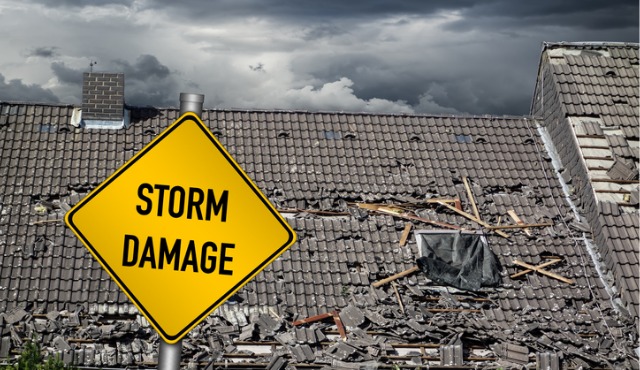By Dixie Somers
Your home's roof takes a beating every day of the year, so storm damage is bound to happen eventually. Some possible forms of damage include stripped shingles from heavy winds, tree damage, water damage, and more. It's crucial to immediately address any roof damages, otherwise a small issue can develop into a huge, expensive catastrophe. Here are four fixes to look out for to repair a roof after a storm.
Clear Debris
After a storm, you may find that your roof has collected debris in the form of tree branches, excess water or snow buildup. This can burden your roof with extra weight and create uneven areas where water can accumulate and potentially cause a leak, mold overgrowth or wood decay. Once the storm clears, get ahead of potential issues by clearing off any debris right away. Don't forget to clean gutters and downspouts, as well.
Take extra caution when climbing a ladder to your roof. Make sure the ladder is tall enough to reach the roof, as well as sturdy enough to take your weight as you climb. Be sure to wear good shoes for working, and be very careful to maintain your balance as you work.
Repair Damaged Shingles
Damaged shingles can expose a portion of your roof to the elements, leaving it vulnerable to sustaining further damage later on. In addition, damaged shingles can open up the interior of your house to pests, such as insects and animals. When it's safe to go outside, examine your roof for missing, cracked or curled shingles and fix them immediately. Apply roofing sealant with a caulking gun to fill in cracked shingles. Roofing sealant can also be used to adhere curled asphalt shingles back into place.
Repair Damaged Flashing
Roof flashing protects areas on the roof where surfaces join, like the chimneys and vent pipes, and helps water flow off the roof and away from the house. Like a damaged shingle, damaged roof flashing exposes part of the underlying roof. To repair damaged flashing, fill or patch corroded holes with roofing cement and refresh the seal by applying caulking to the edges where the flashing meets the roof. Severe damage may require complete removal and replacement of your roof flashing.
Apply Protective Coating
A protective root coating or sealant, such as a fluoropolymer coating, is a cost-effective solution for restoring a roof with mild damage. The right coating also protects your roof from moisture, UV rays, extreme temperatures and weakening joints. If your roof already has a protective coating, you can spot treat damaged areas with a new layer.
Inspect your roof regularly to catch issues in their early stages and plan to repair them as soon as possible. If you don't have the experience or tools to inspect and repair your roof safely, contact a roofing contractor for an estimate.
 Dixie Somers is a freelance writer who loves to write for business, health, and women’s interests. She lives in Arizona with her husband and three beautiful daughters.
Dixie Somers is a freelance writer who loves to write for business, health, and women’s interests. She lives in Arizona with her husband and three beautiful daughters.








